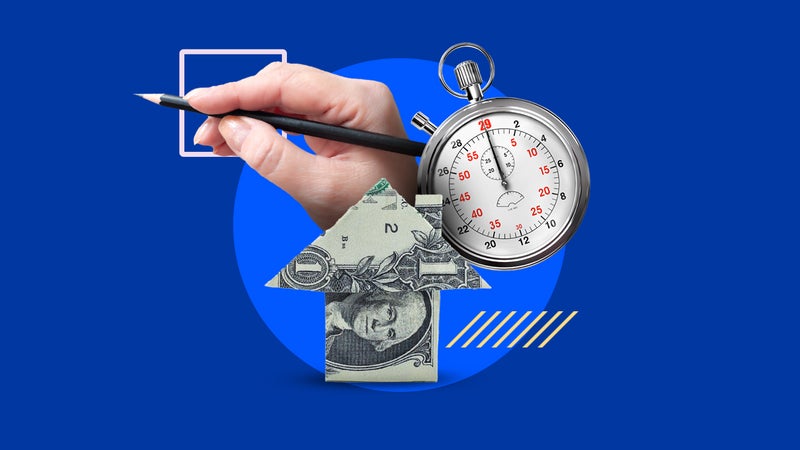Pros and cons of a home equity line of credit (HELOC)

The Bankrate promise
At Bankrate we strive to help you make smarter financial decisions. While we adhere to strict , this post may contain references to products from our partners. Here's an explanation for .
Key takeaways
- A HELOC allows you to access your home’s equity over a period of time — you can borrow exactly what you need as you need it, typically for lower rates than other forms of credit.
- However, HELOCs have variable interest rates, which means you might pay more in interest as rates fluctuate, and your home is the collateral, so if you don’t repay what you borrow, you could lose your home.
Residential real estate just keeps on rising in value — and that means a home can be a valuable source of wealth to tap. One of the most popular ways to do so is via a home equity line of credit, or HELOC. Like a giant credit card, it allows you to borrow from your ownership stake (equity) as needed over a set time frame, then repay it over decades. If you own a sizable amount of your home outright, you may have access to a five or even six-figure sum — often, much more than you could borrow with a personal loan.
There’s a lot to like in a HELOC. However, it also comes with risks. You must put your home up as collateral, and you pay interest at a fluctuating rate — which means it could rise, boosting your repayments dramatically.
Let’s look at all the pros and cons of a HELOC.
Overview: What are the pros and cons of a HELOC?

Pros
- Lower interest rates
- Flexibility
- Tax-deductible interest
- Potential boost to credit

Cons
- Variable rates
- House on the line
- Diminished equity cushion
- Potential to run up balance quickly
Pros of a home equity line of credit
Lower interest rates
While home-loan interest rates overall have risen dramatically since 2022, HELOC rates still tend to be lower than those on credit cards and personal loans. If you qualify for the best rates, a HELOC can be a less expensive way to consolidate debt or finance a home renovation.
Flexibility
With a HELOC, you use the funds as you need them, then repay only what you borrowed (with interest). If you wind up needing less cash than you thought, you’ll have smaller repayments, too. In contrast, home equity loans and personal loans offer a lump sum that has to be repaid in full (also with interest), whether you use all of the money or not.
Most home equity lenders also offer flexibility in terms of how you access your HELOC funds, such as debit cards, checks, ATMs and online transfer. In addition, some allow you to convert all or a portion of your HELOC balance to a fixed rate, so you won’t risk getting hit with higher interest later on.
Another point of flexibility: repayment. Many lenders also offer an interest-only HELOC, with which you only pay interest — no principal — during the draw period (typically 10 years). Doing so helps keep your payments manageable. Of course, you can always opt to pay back principal, all or in part, which in turn elevates your credit line.
Possible tax deduction
Even after the Tax Cuts and Jobs Act of 2017, you can still deduct interest paid on a HELOC if you use the money for home renovations. Specifically, the IRS allows deductions on the interest if the HELOC funds are used to “buy, build or substantially improve the residence.” You can only take the deduction up to a certain threshold, however, based on your total mortgage debt. You must also itemize deductions to take advantage of this write-off.
Potential boost to credit
Two of the most important components of your credit score are your payment history and credit mix. Adding a HELOC to your history and paying it on time can help boost your score. (However, keep in mind that changing your credit utilization ratio by taking on the HELOC could actually make your score go down, too.)
High loan limits
HELOCs are intended for large amounts — at least five figures. Frequently, $10,000 is the minimum credit line you can establish. The benchmark HELOC whose rate Bankrate tracks is for $30,000. Many lenders offer credit lines as high as $500,000 or $750,000.
How big your line of credit is, however, depends on the equity in your home — that is, how much of it you own outright. Generally, you can borrow up to 80 percent of your equity stake — sometimes as much as 90 percent, depending on the lender and your financials. However, your outstanding mortgage also impacts the amount of equity you can tap. When they say you can borrow up to 80 percent, they mean the sum total of all your home-based debt (current mortgage plus new HELOC) can’t exceed 80 percent of your home’s value. In financial-speak, this is called your combined loan-to-value ratio (CLTV).
For example: Assume your home is worth $425,000 and your outstanding mortgage balance is $250,000. This means you have $175,000 in equity and a loan-to-value (LTV) ratio of 59 percent ($250,000 / $425,000 * 100). Your lender lets you borrow up to 80 percent of your equity. That means if lender approves you for a HELOC, your maximum credit line is $90,000 ($425,000 *.80 – $250,000).
Cons of a home equity line of credit
Rates are variable
While home equity loans come with a fixed interest rate, HELOCs have variable rates. This means that your rate can go up or down based on economic conditions, the Fed’s monetary policy and other factors, which in turn affects your payments. Even if you take out a HELOC at a lower rate, you could face much higher interest rates when it comes time to repay.
House is on the line
A HELOC is a secured loan, meaning you put your home up as collateral. While secured loans tend to have lower rates, you’re taking on some additional risk by putting your house on the line. “Because you are borrowing against your home, if you can’t make your monthly payments, you risk foreclosure,” says Sean Murphy, assistant vice president of mortgage operations, closing at Navy Federal Credit Union.
Reduced equity cushion
When you borrow through a HELOC, you’re borrowing against your home’s equity. If home prices drop, you could wind up owing more than your home is worth. In addition, if your home is your largest asset, tying up your equity with a HELOC might limit additional opportunities to borrow, as well as the ability to leverage your equity in an emergency.
Potential to run up balance quickly
Because many HELOCs allow interest-only payments during the draw period, it’s easy to access cash without considering the financial ramifications. “If the borrower is not returning funds to this line of credit, then the loan eventually begins to amortize and the payments go up significantly,” says Joseph Polakovic, owner and CEO of Castle West Financial in San Diego. Bottom line: An unwelcome surprise can await you when the repayment period starts, if you haven’t expected/budgeted for a jump in your monthly payments.
Should you get a HELOC?
HELOCs can be a good option if you have substantial equity in your home and you know you’ll need access to cash with some regularity over a period of time — college tuition bills over the course of several years, for example. If you’re looking to spend as you go, and only pay for what you’ve borrowed when you’ve borrowed it, a HELOC is probably a better option than a lump-sum home equity loan, says Murphy.
However, HELOCs can be risky. The variable interest rate could increase, and if you’re unable to pay back the loan for whatever reason, you could lose your home. In addition, you might end up with a false sense of bottomless funds during the draw period, which can make for a stark return to reality when the payback period begins.
Potential prepayment or early termination penalties
Some lenders assess a fee if you pay off and close your HELOC early — during the draw period, or soon into the repayment period. This can be problematic if you want to retire your debt promptly, instead of taking 10 to 20 years to pay it off. And if you plan to sell your home soon, you could also be penalized since you’re required to repay the balance in full when the home changes title.
Alternatives to a HELOC
Here are some loan alternatives to consider if a HELOC isn’t right for you:
- Home equity loan: A home equity loan is similar to a HELOC, but instead of a credit line, it gives you a lump sum of cash. Repayments begin right away, at a fixed interest rate, meaning your monthly payment will never change. If you know exactly how much you need upfront, and plan to spend it promptly, a home equity loan could be a better option than a HELOC.
- Cash-out refinance: A cash-out refinance replaces your existing mortgage with a new loan that has a bigger balance. You receive the difference in ready money, with the amount based on your home equity (many lenders allow you to borrow up to 80 percent of your home’s value). Generally, a cash-out refi is only a good idea if you can get a lower interest rate, afford the closing costs and plan to stay in your home for a long time.
- Personal loan: Like home equity loans, personal loans come with a fixed monthly payment, a fixed interest rate and a lump sum of money upfront. The big difference between these loans and HELOCs is that personal loans are unsecured, so you don’t have to put your home or any other asset up as collateral. The catch is that they tend to come with higher interest rates than HELOCs, and you may not be able to borrow as much.
Bottom line on HELOC pros and cons
Home equity lines of credit (HELOCs) are an option for disciplined borrowers who want to take advantage of the inherent wealth of their homes. HELOCs have the most flexibility in terms of how much you can borrow and when you can pay it off, compared with other home equity products. Their structure can help you keep your monthly payments down and avoid unnecessary debt and interest.
However, HELOCs also have a variable rate, meaning you could pay a lot more in interest than you bargained for. And the sense of a seemingly limitless credit line could make them risky for less-disciplined borrowers.
When considering a HELOC, think honestly about your financial habits, the potential risks and the nature of your funding needs. HELOCs work best if you require an indefinite sum or need funds for an extended period of time. And the money should go towards improving your home or your financial profile.
HELOC FAQ
-
A home equity line of credit (HELOC) offers a line of credit based on the equity in your home that you can borrow against when you need to.Like credit cards, HELOCs come with variable interest rates.During the draw period, typically 10 years, your monthly payment will vary depending on the current interest rate and how much you borrow at any given time. After the draw period closes, you won’t be able to borrow any more funds and you’ll begin repaying the line plus interest over a repayment period, often up to 20 years.Learn more: What is a HELOC (home equity line of credit)?
-
A HELOC has two distinct stages: a draw period and a repayment period. The draw period is the first stage, usually lasting between five years and 10 years, when you’ll borrow funds as needed. During this time, you might only be required to pay interest. Once the draw period ends, you’ll enter the repayment phase, which can be as long as 20 years. During this time, you’ll repay what you borrowed, plus interest.


